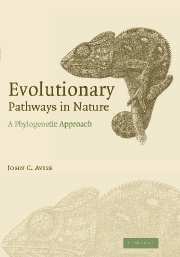Book contents
- Frontmatter
- Contents
- Preface
- Acknowledgments
- 1 Introduction
- 2 Anatomical structures and morphologies
- 3 Body colorations
- 4 Sexual features and reproductive lifestyles
- 5 More behaviors and ecologies
- 6 Cellular, physiological, and genetic traits
- 7 Geographical distributions
- Epilog
- Appendix: a primer on phylogenetic character mapping
- Glossary
- References and further reading
- Index
6 - Cellular, physiological, and genetic traits
Published online by Cambridge University Press: 18 December 2009
- Frontmatter
- Contents
- Preface
- Acknowledgments
- 1 Introduction
- 2 Anatomical structures and morphologies
- 3 Body colorations
- 4 Sexual features and reproductive lifestyles
- 5 More behaviors and ecologies
- 6 Cellular, physiological, and genetic traits
- 7 Geographical distributions
- Epilog
- Appendix: a primer on phylogenetic character mapping
- Glossary
- References and further reading
- Index
Summary
The preceding chapters have dealt primarily with PCM studies of macroscopic external features – organismal morphologies, behaviors, and lifestyles – that are often readily visible to the observer's naked eye. This chapter will illustrate how comparative phylogenetic analyses can likewise be conducted on microscopic internal attributes such as an organism's molecular makeup, cellular functions, physiology, genetic mechanisms, or its intragenomic “microbial associates” (including viruses and transposable elements). We will consider, for example, what PCM has revealed about the evolutionary-genetic underpinnings of sex determination, of eye development, of metazoan (multi-cellular animal) body plans, and of cellular mechanisms for DNA repair. We will consider how various fishes evolved antifreeze proteins, the capacity to produce electrical currents, and warm-bloodedness. And we will track the recent evolutionary history of the HIV viruses that cause AIDS. In truth, almost any subject related to cellular biology, ranging from biochemistry to medicine and epidemiology, can be informed to one degree or another by comparative phylogenetic analyses.
Foregut fermentation
Most of the studies described in this book have employed molecular data as phylogenetic backdrops for interpreting the evolutionary histories of morphological or other organismal phenotypes. The general rationale, of course, is that, when species are assayed for hundreds or thousands of detailed genetic characters (as is typically the case with protein or DNA sequence information, for example), any widespread and intricate molecular similarities that might be observed are very unlikely to have arisen by convergent evolution, so they must instead reflect true phylogenetic descent.
- Type
- Chapter
- Information
- Evolutionary Pathways in NatureA Phylogenetic Approach, pp. 153 - 189Publisher: Cambridge University PressPrint publication year: 2006



